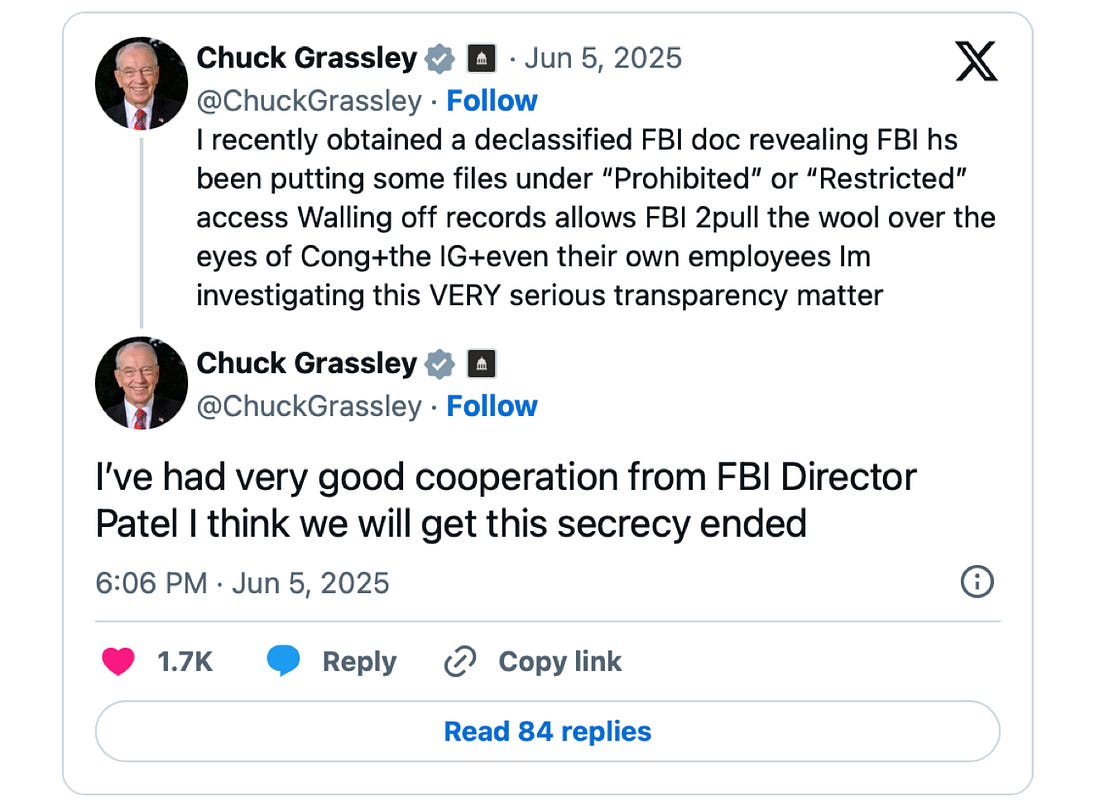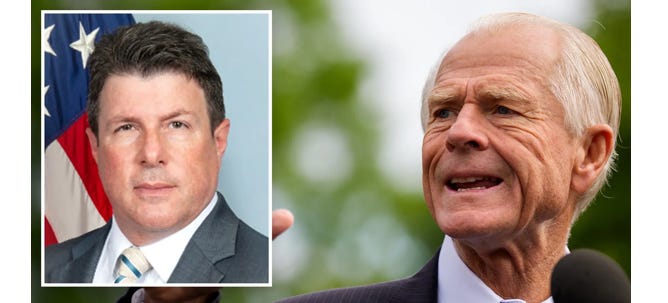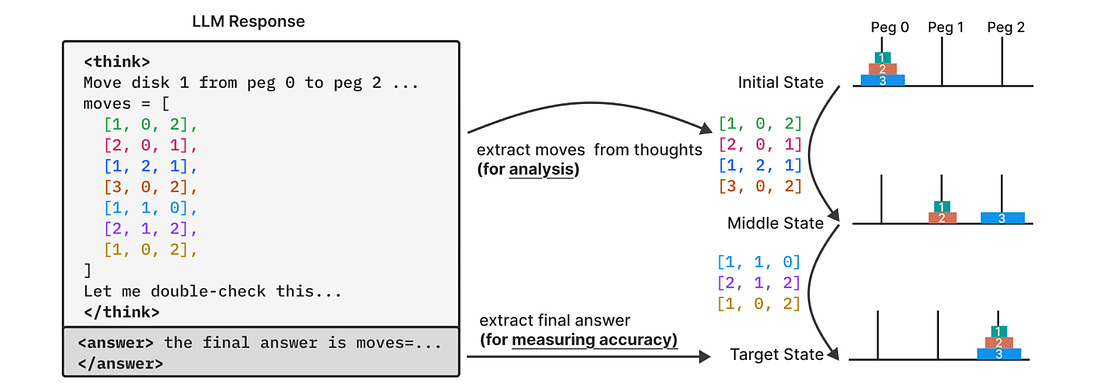C&C. UN REASONABLE. Peaceful Violence. Grassley + Patel. AI Has Limits.
June 8 | Posted by mrossol | AI, American Thought, Childers, Deep State, Democrat Party, FBI, Illegal Aliens, Intelligence Services, Law, TrumpIf they love Mexico so much to be waving its flag while ‘protesting’ why are they in LA.? Mostly peaceful looters torch LA; Trump sends the Guard while Newsom frets about optics. Hopefully Grassley will expose what “they” are hiding. FBI’s secret files probed; AI hits limits; and I warned them masks would backfire.
Source: UN REASONABLE ☙ Sunday, June 8, 2025 ☙ C&C NEWS
WORLD NEWS AND COMMENTARY
🔥🔥🔥
Since January, more judges than I can count have tripped over themselves denying President Trump’s declaration of “an invasion” at the southern border. Yesterday, the New York Times ran a fretful story headlined, “Trump to Send National Guard to LA to Quell Immigration Protests.” The sub-headline angrily added, “Gov. Gavin Newsom called the decision to call in National Guard forces ‘purposefully inflammatory.’”
President Trump, ignoring Governor Hair Gel’s hand-wringing, activated 2,000 National Guardsmen yesterday to contain swelling crowds of masked foreign nationals waving Mexican flags, looting stores, and torching U.S. streets in Los Angeles. Even during the 2020 Summer of Mostly Peaceful Molotovs™, while the same tired protest playbook played out, Trump never invoked this extraordinary authority.
For context, it’s been sixty years since a president overrode a governor to deploy the Guard, when in 1965 LBJ ordered troops into Alabama to supportcivil rights protesters. This time, the troops’ job is to suppress anti-enforcement protesters. It’s a perfect rhyming couplet of history.
“Governors,” the Times correctly noted, “almost always control the deployment of National Guard troops in their states.” But a specific provision within Title 10 of the U.S. Code allows federal deployment of the National Guard if “there is a rebellion or danger of a rebellion against the authority of the Government of the United States.”
Media was outraged. But … but … the protests have been mostly peaceful!Mostly. In a paroxysm of understatement, the Times euphemistically admitted, “Some demonstrations have been unruly.”
Unruly could describe a high-school cafeteria food fight. Watch out for the jello salad! The pictures and video coming out of LA look more like Tenochtitlán’s revenge tour.
Title 10 also allows the president to call up “members and units of the National Guard of any State in such numbers as he considers necessary to repel the invasion.” One wonders whether the sneering judges would agree that “unruly” mobs of masked foreigners carrying flags from a foreign nation, rioting in U.S. streets, looting retail stores, and violently resisting federal law add up to a rebellion or invasion. In their unelected opinions, of course.
If this isn’t an invasion, what is it? A street festival, with explosives?
🔥 There’s something deeply, almost comically incongruous about the protests. Foreign nationals, many here illegally, are taking to American streets to protest U.S. immigration enforcement— while proudly waving the Mexican flag.
But … if they love Mexico so much, why are they here?
And, if being returned there is some kind of human rights violation, then what exactly does the flag stand for? National pride? Or personal trauma? You can’t claim asylum from a terrifying hellhole of a country while simultaneously celebrating it like you’re marching in the Noche de Rábanos parade.
If this were really about asylum, we’d see desperate appeals to law, to justice, and especially to American ideals. Instead, we’re watching coordinated displays of foreign national identity, wrapped in defiance rather than desperation. That’s not a cry for help. That’s a declaration of something.
When you combine the widespread waving of other countries’ flags, the open rejection of U.S. law, organized street violence, looting, and arson, and the refusal to return to the country they claim to love, the “asylum” narrative starts to look like a fig leaf for something else. It is more like political colonization by crowd.
In short: an invasion.
🔥 Upon hearing yesterday’s National Guard news, progressives tightly clutched their pearl necklaces. “It is using the military domestically to stop dissent,” wailed Erwin Chemerinsky, 72, UC Berkeley’s wispy-haired law school dean. Erwin’s far-left blood ran cold. He darkly labeled Trump’s override as “truly chilling.”
For his own reasons, the state’s hapless Governor did not welcome the help. He didn’t criticize the rioting illegals, who rolled right over local police. No, Gavin criticized President Trump, calling the unsolicited National Guard help “inflammatory.”
News flash: it’s already burning.
Oh, Gavin. Once the manicured front-runner for the post-Biden progressive baton, the Governor now finds himself shrieking “inflammatory!” while the streets of his biggest city literally burn in flames. It’s not the best audition clip for Commander-in-Chief. When his presidential campaign’s soft-launch looks more like the fall of Saigon than the dawn of Camelot, maybe he should rethink the messaging.
And the story provided me with another “I told you so moment.”
🔥 Back in 2020, when I sued Alachua County over its covid-era mask mandate, I didn’t just argue the science was flimsy and the policy was unconstitutional— I also warned it would open the door to criminal anonymity. In my appellate brief, I quoted a 2000 Georgia Supreme Court decision that called face masks “the criminal’s dress.” I devoted five full pages (over 10% of the brief) to the idea that letting people legally obscure their identities in public would ultimately do far more harm than good.
Yesterday, President Trump finally caught up to my 2020 brief. Reuters ran the story: “Trump bans masks at protests after LA unrest.” In the President’s own words:
So, in one sense, LA’s illegal alien riots and the federal response are a much bigger story than they appear in corporate media’s carefully crafted rear-view mirror. This was also a return of sanity, reviving a pre-pandemic point of moral clarity, the prodigal return of common knowledge and common sense.
It’s a simple truth we once knew but were bullied into forgetting: Masks are bad news. They’re not any symbol of virtue. They’re not an altruistic signal of “care for others.” Masks are just a convenient disguise for criminals and cowards— one that gave cover to the worst among us, while silencing the best.
🔥🔥🔥
Last week, I told you about the FBI’s favorite magic trick: tagging documents with “Prohibited” or “Restricted Access” flags, making them invisible to oversight requests— poof!, like Deep State David Copperfield. On Friday, The Federalist confirmed that the Senate Judiciary Committee has cracked open this digital oubliette and wants to know what’s inside. The Federalist ran a very welcome story headlined, “Judiciary Expands Probe Of Hidden Or Destroyed FBI Docs.”
Three days ago, Senate Judiciary Committee Chairman Chuck Grassley (R-Iowa) asked Attorney General Pam Bondi and FBI Director Kash Patel to locate and turn over all Prohibited Access records related to Special Counsel Robert Mueller and the Biden family. As Grassley’s tweet explained, the Senator reported receiving “very good cooperation from FBI Director Patel.”
Before this week, Congress didn’t even know the magic words to get the most important documents from the FBI, which was already stonewalling and quibbling like a Mediterranean oil vendor over the requests Congress could cobble together. The FBI’s resistance was a smoke screen meant to confuse Congress into thinking it finally got something useful two years later when the smoke cleared.
But they’d never even asked for “prohibited access” documents to start with.
The story reported that the Committee is also looking skeptically at some of the FBI agents involved in the RussiaGate hoax. According to whistleblowers, Mueller henchman and FBI agent Andrew Weissmann repeatedly wiped his government phone. Another agent, Walter Giardina, is accused of falsely validating the Steele Dossier, openly hating Trump, and (of course) bleachbitting a key government laptop. These aren’t bureaucratic accidents— they’re acts of sabotage.
Despite Grassley’s tweet and the Senate hearings, corporate media has completely ignored the “prohibited access” story, not even seeking to discredit or whitewash it, which tells you they’re terrified of the story.
This time, Republicans in Congress don’t face Grandma Garland and his wrecking crew of two-tier enforcers. Kash Patel is likely to dish the goods. With the midterms racing down the political pike, one wonders what the newly disclosed “prohibited access” evidence might show. How bad might it be?
🔥 Is this story part of Trump’s larger strategy to slowly kill off the deep state through disclosure? If Trump has an unstated but obvious doctrine in his second term, it’s not “drain the swamp” as much as it’s death by a thousand credibility cuts— the slow, steady campaign to discredit, demoralize, and ultimately dismantle the permanent security state.
The revelation that FBI brass tucked away politically sensitive files behind invisible access barriers doesn’t only outrage MAGA— it might serve a larger strategic purpose. It’s not just about the RussiaGate scandal. It’s about ripping the mask off a decades-long pattern of abuse, concealment, and elite impunity.
The President has completely flipped it around on them. Trump isn’t the defendant anymore; the institutions are. “They tried to frame me,” he says, “and here comes the proof.”
Whether or not the steady stream of embarrassing disclosures ever lead to charges is almost beside the point. The bigger and more lasting win for Trump is cultural: converting the FBI, DOJ, CIA, and parts of the Pentagon into political liabilities for Democrats. That might be the only way to permanently deconstruct the administrative state— not just through firings and office relocations, but by ruining its reputation beyond salvage.
🔥 Consider this: not even a year ago, up till the day Trump won the election, the phrase “no one is above the law” appeared every single day in every major newspaper and in countless judicial opinions. The slogan was a holy incantation, repeated like a Gregorian chant— on every op-ed page, chiseled into every chyron, sanctified by every blue-checked legal analyst. It was the mantra used to justify the prosecutions, the raids, the gag orders, and the censorship.
But now, a few fast months later, “no one is above the law” is the punchline to a bad joke, a crusty relic considered to be a worn-out cliché.
Unless I am missing something, Trump is quietly and carefully tearing to shreds the protective bubble of trust wrapping the intelligence state. It’s not about winning a lawsuit or a criminal conviction. It’s about shredding the aura of nonpartisan impartiality that once protected the agencies like Kevlar.
The intelligence state doesn’t need public approval to function— but it does need public deference. Trump is targeting the invisible currency of trust that lets the FBI and CIA operate behind closed doors without public opposition. And that’s why it’s working: not through lawfare, but through narrative disarmament.
By the time he’s done, even the people who once reflexively defended these institutions will hesitate. And once that hesitation sets in —once that sacred trust is gone— it’s game over. No secret agency can long survive in a democracy once the spell breaks.
Tick, tock.
🔥🔥🔥
Finally, let’s unpack some more black-pilled AI doom-and-gloom. Yesterday, Psychology Today ran a story headlined, “Did Complexity Just Break AI’s Brain?” The sub-headline added, “A new report from Apple shows AI fails hardest where it should excel.”
This week, Apple released a peer-reviewed AI study titled, “The Illusion of Thinking: Understanding the Strengths and Limitations of Reasoning Models via the Lens of Problem Complexity.” It rocked the AI world, though so far corporate media showed all the alertness and volume of sleepy garden crickets.
Apple researchers tested the “smartest” AI models —called Large Reasoning Models (LLMs)— with middle-school logic puzzles. For instance, they used the Towers of Hanoi and the old chestnut about the river-crossing Farmer with a fox, a chicken, and a bag of grain. They found a point where all the models failed —solutions “fell to zero”— when the puzzles got sufficiently complicated.
I’ve been reporting for ages that nobody really understands how AI does its thing. That admission appeared right in the study’s opening paragraph. “While these models demonstrate improved performance on reasoning benchmarks,” the researchers wrote, “their fundamental capabilities, scaling properties, and limitations remain insufficiently understood.”
The study concluded that LLMs only pretend to reason like humans. The truth is, the computers are just matching patterns. For instance, they may be able to solve a complex math equation or beat a master chess player, but that is only because their databases include millions of chess permutations. If you give them a novel problem that can only be solved with logic —with pure reasoning— instead of by brute force, the AI suddenly falls off a cliff.
AI defenders raced out in force, illogically arguing that Apple is just jealous because it lags behind in AI development, and unpersuasively arguing that, in an AI age, we must re-define what “thinking” means.
What would we do without the flexibility of redefining basic vocabulary?
🔥 For upwards of two years now, we’ve been breathlessly assured that AI “super-intelligence” is mere moments away, just like how Iran’s nuclear weapons program is always two weeks from readiness, but never actually arrives. For example, behold this breathless op-ed headline from Newsweek, just last month:
Yesterday, I listened to an apocalyptic podcast between a New York Times science reporter and a former OpenAI engineer. The developer gloomily predicted that the technology would achieve “artificial general intelligence” (AGI) within 18 months, and the pair spent the rest of the talk discussing a parade of horrors, ranging from the need for universal basic income to support displaced human workers to the violent collapse of civilization itself.
Don’t get me wrong. There’s much we don’t know about AI and its capabilities. We don’t even understand how it works. It continues to surprise developers who, like Spanish explorers of old, keep finding new, unexpected behaviors in the digital wilderness. But Apple’s researchers just found a hard upper limit on something humans can do fairly easily— but that AI apparently cannot.
It’s not that AI isn’t powerful. It is. It can crush repetitive tasks, mimic human syntax, and win debates it doesn’t even understand. But it’s not thinking. Not really. It’s just guessing. Guessing very well, and with flair. It is going to change everything. But this is the first evidence that it can’t replace people. Not this type of AI, anyway.
🔥 You’d think the AI community would be relieved—maybe even humbled—by Apple’s revelation. After all, if AI has a ceiling, it means we might not be facing an extinction-level event in the next update cycle. But instead of sighs of relief, we see snarls and snark. Why on Earth?
There’s a simple explanation why AI developers aren’t celebrating Apple’s study, and it is as old as humanity itself: the money train.
The AI gold rush is fueled not by truth, but by fear and fantasy. The more AI sounds like magic, the bigger the checks get— from venture capitalists, government contractors, and defense departments. Doomsday sells. Apocalypse, with a UI, sells even better. Because after all, we can’t let the Chinese get there first!
But if you were looking for a flicker of hope in the maelstrom of AI hype, Apple just snapped the cigar lighter’s wheel. The inescapable conclusion —assuming their research holds— is that this type of AI will never achieve AGI, certainly not anytime soon. There’s a structural limit.
Which is very good news.
🔥 If Apple is right—if this branch of AI, this architecture, has a built-in structural ceiling— then we’re not watching the rise of Skynet. We’re watching the rise of a powerful, disruptive tool. Compare it instead to things like the steam engine, the printing press, or the internet.
As regular readers know, my undergrad degree is in economics. Disruptive technology is fairly well understood. Mass layoffs are always predicted as disruptive tech emerges— but have never actually appeared, except perhaps on very short timelines.
The explanation is simple and logical. Let’s use AI as an example. As AI replaces call-center operators, basic bookkeepers, truck drivers, and school teachers, companies that employed them enjoy higher productivity and lower costs. That means more money for other things they couldn’t afford before.
If a business saves $10 million on payroll because AI answers the phones, it doesn’t bury that money in the backyard— it hires more developers, expands product lines, invests in marketing, builds something new. That’s how markets have always worked.
Some people screamed that ATMs would kill the banking industry. They didn’t. The industry changed, and brands consolidated, but banks are still building branches. The same thing happened with spreadsheets, email, and automated manufacturing.
With this much epistemological fog, technological hubris, and money in the wind, any confident forecast belongs in the fiction section. But if you’ve been waiting for a silver lining —something to pierce AI’s apocalyptic cloud cover— Apple may have just delivered.
Like Cortez’s hardy band climbing the final ridge and beholding the Pacific Ocean with a wild surmise, AI researchers may have finally crested the summit of their limitless ambitions— only to discover that the horizon is not infinite after all.
So hang in there. As somebody once said (I can’t remember who): weeping may endure for a night, but joy cometh in the morning.
Have a blessed and joyful Sunday! We’ll pick the threads back up tomorrow morning, as we kick off the week right with a new roundup of essential news and commentary. Thank you for your continuing loyal support.
Don’t race off! We cannot do it alone. Consider joining up with C&C to help move the nation’s needle and change minds. I could sure use your help getting the truth out and spreading optimism and hope, if you can:☕ Learn How to Get Involved 🦠
















Leave a Reply
You must be logged in to post a comment.